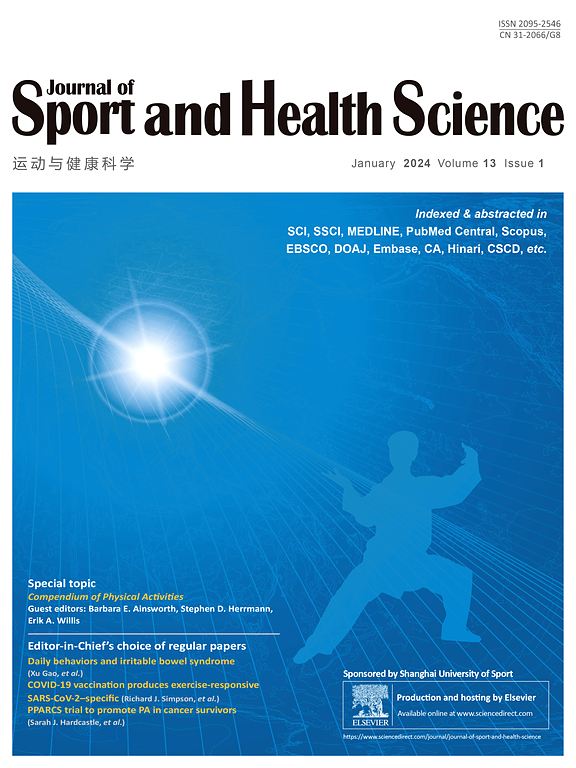Exercise suppresses osteoclastogenesis by increasing the secretion of muscle-derived L-β-aminoisobutyric acid.
IF 10.3
1区 医学
Q1 HOSPITALITY, LEISURE, SPORT & TOURISM
引用次数: 0
Abstract
BACKGROUND Exercise is a key strategy for combating bone loss in individuals with postmenopausal osteoporosis (PMOP). L-β-aminoisobutyric acid (L-BAIBA), an exercise-responsive myokine, is secreted at elevated levels during physical activity. However, the role of exercise-induced L-BAIBA secretion in PMOP remains unclear. In this study, we aimed to evaluate the therapeutic efficacy of L-BAIBA in mitigating bone loss using an ovariectomized (OVX) mouse exercise-induced model. METHODS An OVX mouse model was established to simulate PMOP. Primary bone marrow-derived macrophages, murine muscle satellite cells (MuSCs), and human peripheral blood mononuclear cells were isolated and cultured. We hypothesized that exercise-induced L-BAIBA release would attenuate PMOP by suppressing osteoclastogenesis. To test this hypothesis, we conducted the following experiments: (a) measured plasma L-BAIBA concentrations, femoral morphology and biomechanical properties, and bone resorption markers in OVX mice following 8 weeks of treadmill exercise, and assessed osteoclast induction in vitro induction using conditioned co-cultures of stretched primary MuSCs; (b) repeated the same measurements after 8 weeks of daily L-BAIBA administration (150 mg/kg) to OVX mice; (c) investigated molecular signaling pathways associated with L-BAIBA action; and (d) examined the correlation between L-BAIBA plasma concentration and bone mineral density (BMD) in women with PMOP. RESULTS Exercise increased L-BAIBA secretion, suppressed osteoclastogenesis, and reduced bone loss in OVX mice. L-BAIBA supplementation similarly inhibited osteoclastogenesis both in vivo and in vitro. Mechanistically, L-BAIBA acted through the taurine transporter solute carrier family 6 member 6 (SLC6A6), downregulated phosphatidylinositol 3-kinase (PI3K)/serine/threonine-protein kinase (AKT)/nuclear factor kappa-B (NF-κB) signaling, and activated the nuclear factor erythroid 2-related factor 2 (NRF2) anti-oxidant system. L-BAIBA levels were significantly reduced in women with PMOP and positively correlated with BMD. CONCLUSION Exercise suppresses osteoclastogenesis by enhancing L-BAIBA secretion. These findings provide new insights into the mechanisms underlying the skeletal benefits of exercise and highlight L-BAIBA's therapeutic potential as a novel agent for managing PMOP.运动通过增加肌肉来源的L-β-氨基异丁酸的分泌来抑制破骨细胞的生成。
背景:运动是对抗绝经后骨质疏松症(PMOP)患者骨质流失的关键策略。L-β-氨基异丁酸(L- baiba)是一种运动反应性肌肉因子,在体育活动中分泌水平升高。然而,运动诱导的L-BAIBA分泌在ppu中的作用尚不清楚。在这项研究中,我们旨在通过卵巢切除(OVX)小鼠运动诱导模型来评估L-BAIBA减轻骨质流失的治疗效果。方法建立OVX小鼠模型,模拟PMOP。分离培养原代骨髓源性巨噬细胞、小鼠肌卫星细胞(MuSCs)和人外周血单核细胞。我们假设运动诱导的L-BAIBA释放可以通过抑制破骨细胞生成来减弱ppu。为了验证这一假设,我们进行了以下实验:(a)在8周的跑步机运动后,测量OVX小鼠的血浆L-BAIBA浓度、股骨形态和生物力学特性以及骨吸收标志物,并通过拉伸原代musc的条件共培养评估体外诱导破骨细胞的诱导作用;(b) OVX小鼠每日给予L-BAIBA (150 mg/kg) 8周后重复相同的测量;(c)研究与L-BAIBA作用相关的分子信号通路;(d)检测L-BAIBA血浆浓度与ppu女性骨密度(BMD)的相关性。结果运动可增加OVX小鼠L-BAIBA分泌,抑制破骨细胞生成,减少骨质流失。在体内和体外,补充L-BAIBA同样可以抑制破骨细胞的发生。机制上,L-BAIBA通过牛磺酸转运体溶质载体家族6成员6 (SLC6A6),下调磷脂酰肌醇3-激酶(PI3K)/丝氨酸/苏氨酸蛋白激酶(AKT)/核因子κ b (NF-κB)信号通路,激活核因子红细胞2相关因子2 (NRF2)抗氧化系统。L-BAIBA水平在ppu患者中显著降低,并与骨密度呈正相关。结论运动通过增强L-BAIBA分泌抑制破骨细胞的形成。这些发现为运动对骨骼益处的潜在机制提供了新的见解,并突出了L-BAIBA作为治疗ppu的新药物的治疗潜力。
本文章由计算机程序翻译,如有差异,请以英文原文为准。
求助全文
约1分钟内获得全文
求助全文
来源期刊

Journal of Sport and Health Science
SPORT SCIENCES-
CiteScore
18.30
自引率
1.70%
发文量
101
审稿时长
22 weeks
期刊介绍:
The Journal of Sport and Health Science (JSHS) is an international, multidisciplinary journal that aims to advance the fields of sport, exercise, physical activity, and health sciences. Published by Elsevier B.V. on behalf of Shanghai University of Sport, JSHS is dedicated to promoting original and impactful research, as well as topical reviews, editorials, opinions, and commentary papers.
With a focus on physical and mental health, injury and disease prevention, traditional Chinese exercise, and human performance, JSHS offers a platform for scholars and researchers to share their findings and contribute to the advancement of these fields. Our journal is peer-reviewed, ensuring that all published works meet the highest academic standards.
Supported by a carefully selected international editorial board, JSHS upholds impeccable integrity and provides an efficient publication platform. We invite submissions from scholars and researchers worldwide, and we are committed to disseminating insightful and influential research in the field of sport and health science.
 求助内容:
求助内容: 应助结果提醒方式:
应助结果提醒方式:


